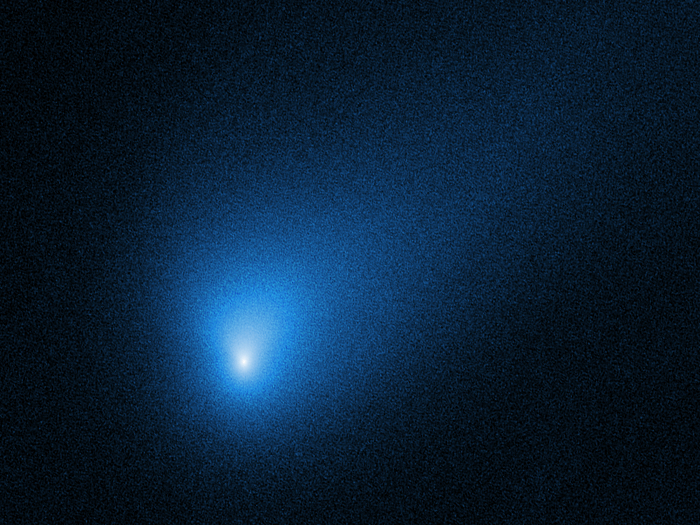
Over the past five years, I discovered with my student, Amir Siraj, two interstellar meteors in the CNEOS fireball catalog of NASA: IM1 — detected on January 8, 2014 near Papua New Guinea, and IM2 — detected on March 9, 2017 near Portugal. This constitutes half of the four interstellar objects bigger than dust that were ever discovered by astronomers. The other two are `Oumuamua, detected on October 19, 2017, and Borisov, detected on August 29, 2019. All four were discovered over the past decade by new telescope systems that were not available prior to that. They were found to be moving faster than the escape speed from the Solar system and must have originated outside of it.
Their chronological order matches their ranking in size: based on the energy released in the brightest phase of their fireballs, IM1 was half a meter and IM2 was a meter in radius. `Oumuamua was roughly a hundred meters and the nucleus of Borisov was about a few hundred meters in radius. Whereas the first two interstellar objects were spotted by the radiation produced when they burned up in the Earth’s atmosphere, the last two were identified through their reflection of sunlight far from Earth, hence the requirement for their bigger size. There are a million interstellar objects like IM1 & IM2 for every `Oumuamua-size object within the orbit of the Earth around the Sun, but they are too small to be detectable by their reflection of sunlight. They represent invisible fish that are captured once per decade because the Earth is a tiny fishing net, a billion times smaller in area than the orbit of the Earth around the Sun.
Among the four interstellar objects, only Borisov appeared familiar. It was a comet, not much different from the analogous snowballs found in the Solar system. My late colleague, Fred Whipple, realized in 1950 that comets are made of ice and rock after noticing “dirty snowballs” while walking through Harvard Yard on a snowy winter day.
Imagine four objects from the street in your backyard, with the first three unlike anything seen before. Common sense would argue that these three objects originated in environments very different from your backyard.
Now consider the first three objects that arrived to the Solar system from interstellar space. `Oumuamua appeared flat, had an extreme shape, was pushed away from the Sun with no visible cometary tail, and was closer in velocity to the Local Standard of Rest than 99.8% of all stars. The interstellar meteors IM1 & IM2 had material strength tougher than iron and 270 out of the other 271 meteors in the CNEOS catalog, making them outliers in material strength at the 99.99% level. Attempts to explain the anomalies of `Oumuamua by a natural origin, involved objects that were never seen before: a dust bunny, a hydrogen iceberg or a nitrogen iceberg. If IM1 & IM2 originated from a natural origin, the population of sources must have locked about 40% of all refractory elements in interstellar objects based on the extraordinary material strength exhibited by IM1 & IM2.
The only way to resolve these puzzles is to acquire more data on interstellar objects. The Galileo Project was just funded at $1.5M to carry out an expedition that aims to collect the fragments of IM1 and analyze their composition. The Project also plans to identify the “next `Oumuamua” in the LSST data stream of the Vera C. Rubin Observatory and design a space mission that will rendezvous with the object.
These interstellar objects from our cosmic neighborhood could also be artificial in origin, just like tennis balls on the backdrop of familiar rocks in our back yard. In that case, interstellar objects could either be “space trash” or functional. An example for the first category is the rocket booster 2020 SO, which was launched by NASA in 1966 and was re-discovered in space on September 17, 2020 by Pan STARRS — the telescope which discovered `Oumuamua. Just like `Oumuamua, 2020 SO showed no cometary tail and was pushed away from the Sun by reflecting sunlight with its thin walls.
The unique quality of functional devices is that they can target the habitable zone of the Sun. In that case, the abundance inferred from their detection rate near Earth could be lowered by 16 orders of magnitude, the ratio between the volume of interstellar space around the Sun and the habitable volume around it.
In a new paper with my student, Carson Ezell, we calculated the expected distribution of artificial objects in the disk of the Milky-Way galaxy based on the detection rate of IM1, IM2 and `Oumuamua. The tyranny of the rocket equation keeps all chemically-propelled spacecraft below the escape speed from the Milky Way disk. Their scale height above the disk plane is dictated by their typical ejection speed from their parent systems.
When Enrico Fermi asked: “where is everybody?”, he did not have access to data from survey telescopes like Pan STARRS or the satellites that revealed the meteors in the CNEOS catalog. As scientists, we have an obligation to identify the nature of anomalous objects from interstellar space because they might inform us about our neighbors. It would be ironic if the SETI community will keep looking for radio signals from far away, while extraterrestrial gadgets are zooming through the Solar system. Such circumstances would resemble an attempt to contact our neighbors over the phone, while ignoring intriguing evidence that their cars may be crossing our driveway.
Altogether, we must be missing something fundamental about our cosmic neighborhood. Both dark matter and interstellar objects are passing through the Solar system, and we do not know the nature of either of them. Although dark matter makes 82% of the matter budget in the cosmos, its nature has limited significance for the future of humanity. After figuring out its sterile nature, we will continue to focus our attention on the ordinary matter that makes humans and all physical objects we interact with.
However, if the expedition to Papua New Guinea will reveal that IM1 was made out of an artificial alloy, this realization will change our technological self-esteem, our aspirations for space and our long-term agenda. We are making gadgets on our own; hence, the knowledge that IM1 is an extraterrestrial gadget will hit us close to home — even for those living far from the Pacific Ocean.
ABOUT THE AUTHOR

Avi Loeb is the head of the Galileo Project, founding director of Harvard University’s — Black Hole Initiative, director of the Institute for Theory and Computation at the Harvard-Smithsonian Center for Astrophysics, and the former chair of the astronomy department at Harvard University (2011–2020). He chairs the advisory board for the Breakthrough Starshot project, and is a former member of the President’s Council of Advisors on Science and Technology and a former chair of the Board on Physics and Astronomy of the National Academies. He is the bestselling author of “Extraterrestrial: The First Sign of Intelligent Life Beyond Earth” and a co-author of the textbook “Life in the Cosmos”, both published in 2021.
